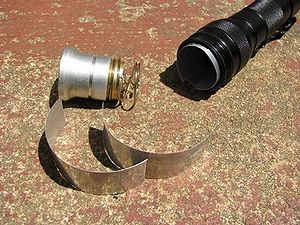Difference between revisions of "P60"
(Created page with "Surefire created an assembly called P60 that goes inside some of its flashlights. It is a 6-volt incandescent bulb and reflector assembly (for instance, the Surefire 6P, M2, and ...") |
|||
| Line 1: | Line 1: | ||
Surefire created an assembly called P60 that goes inside some of its flashlights. It is a 6-volt incandescent bulb and reflector assembly (for instance, the Surefire 6P, M2, and G2 flashlights all use the P60 assembly). They also make a LED version called a P60L and 9-volt versions called P90 and P90L that are the same size. This became an industry standard and now many companies offer '''P60 drop-ins''' (the bulb and reflector assembly regardless of bulb type or voltage) and '''P60 hosts''' (flashlight bodies that accept the drop-ins). Some companies avoid the Surefire naming system by calling P60 a D26 (the bezel diameter is 26.5 mm) or won't even mention P60 at all. No soldering is required: you just unscrew the head of the light, drop the assembly into the host, put the head back one, and you are ready to go. | Surefire created an assembly called P60 that goes inside some of its flashlights. It is a 6-volt incandescent bulb and reflector assembly (for instance, the Surefire 6P, M2, and G2 flashlights all use the P60 assembly). They also make a LED version called a P60L and 9-volt versions called P90 and P90L that are the same size. This became an industry standard and now many companies offer '''P60 drop-ins''' (the bulb and reflector assembly regardless of bulb type or voltage) and '''P60 hosts''' (flashlight bodies that accept the drop-ins). Some companies avoid the Surefire naming system by calling P60 a D26 (the bezel diameter is 26.5 mm) or won't even mention P60 at all. No soldering is required: you just unscrew the head of the light, drop the assembly into the host, put the head back one, and you are ready to go. | ||
[[File:P60dropin-and-strips.jpg|thumb|P60 drop-in with a UltraFire WF-502B host and aluminum strips for heatsinking]] | |||
Make sure you match up voltage requirements. For instance if you get a 3.7-4.2V drop-in, don't operate it using two CR123A batteries which would be 6V. LED drop-ins include the reflector, LED, and [[driver]] and are available as single mode or multi-mode, though the drivers could be swapped out separately to change that (requires soldering). The [http://www.candlepowerforums.com/vb/forumdisplay.php?f=45 LED forum] of CPF has a sticky listing P60 drop-ins with a link to a list of P60 hosts. The advantage of the P60 system is that once you find a host you like, you can upgrade to a newer LED by just buying a new drop-in which will come with a reflector and driver designed for that particular LED. | Make sure you match up voltage requirements. For instance if you get a 3.7-4.2V drop-in, don't operate it using two CR123A batteries which would be 6V. LED drop-ins include the reflector, LED, and [[driver]] and are available as single mode or multi-mode, though the drivers could be swapped out separately to change that (requires soldering). The [http://www.candlepowerforums.com/vb/forumdisplay.php?f=45 LED forum] of CPF has a sticky listing P60 drop-ins with a link to a list of P60 hosts. The advantage of the P60 system is that once you find a host you like, you can upgrade to a newer LED by just buying a new drop-in which will come with a reflector and driver designed for that particular LED. | ||
Revision as of 19:57, 28 November 2010
Surefire created an assembly called P60 that goes inside some of its flashlights. It is a 6-volt incandescent bulb and reflector assembly (for instance, the Surefire 6P, M2, and G2 flashlights all use the P60 assembly). They also make a LED version called a P60L and 9-volt versions called P90 and P90L that are the same size. This became an industry standard and now many companies offer P60 drop-ins (the bulb and reflector assembly regardless of bulb type or voltage) and P60 hosts (flashlight bodies that accept the drop-ins). Some companies avoid the Surefire naming system by calling P60 a D26 (the bezel diameter is 26.5 mm) or won't even mention P60 at all. No soldering is required: you just unscrew the head of the light, drop the assembly into the host, put the head back one, and you are ready to go.
Make sure you match up voltage requirements. For instance if you get a 3.7-4.2V drop-in, don't operate it using two CR123A batteries which would be 6V. LED drop-ins include the reflector, LED, and driver and are available as single mode or multi-mode, though the drivers could be swapped out separately to change that (requires soldering). The LED forum of CPF has a sticky listing P60 drop-ins with a link to a list of P60 hosts. The advantage of the P60 system is that once you find a host you like, you can upgrade to a newer LED by just buying a new drop-in which will come with a reflector and driver designed for that particular LED.
One problem with P60 drop-ins is they do not always transfer heat from the LED and driver to the host which can cause the LED to overheat. Some people will stuff aluminum foil around the drop-in to provide a better heat path between the drop-in and the head of the light. Aluminum strips, copper tape, or copper wire can also be used. You could use thermal compound, but this would make it much more difficult to swap drop-ins. Even with these measures in place, it may not be advisable to use higher power LED's (like the Cree MC-E or Luminus SST 50) in a P60 host.
Other drop-in sizes include D36 with a 36mm reflector.
